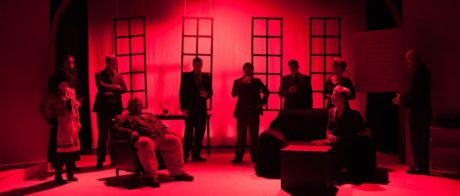For Allens Lane Theater’s production of And Then There Were None, director Josh Hitchens not only presents the mystery, but also heightens the mood and highlights the message inherent in Agatha Christie’s all-time best-selling novel (with sales of over 100 million copies) of 1939. And he does that by restoring the author’s original ending and honoring its impactful intent, rather than using the less horrific conclusion of her revised stage adaptation of 1944.

The classic whodunit tale of murder, guilt, and retribution is set in a house on an isolated island off the rocky English coast of Devon, to which ten people have been invited by an unknown absentee host. Trapped by a violent storm, they soon become aware that they have been lured there by one of the ten of them, to exact punishment for the killings they committed in the past, from which they have all escaped justice. One by one, they pay for the crimes with their lives, as foreshadowed in Frank Green’s unsettling 19th-century nursery rhyme “Ten Little Soldiers” (“Ten little soldier boys went out to dine/One choked his little self and then there were Nine . . .”), prominently displayed on a signboard in the parlor.
As the characters become increasingly unhinged, they reveal the heinous actions that haunt them, or for which they feel no remorse, and try, along with the audience, to ascertain, before it’s too late, who among them is the deadly avenger. With each death, a toy soldier mysteriously disappears from a table in the room until no one is left, in keeping with the poem’s eponymous last line: “And then there were none.” It is only after the last soldier is gone that the identity of the murderous mastermind becomes known, and the subtle clues sprinkled throughout the story fall into place.
For those who aren’t familiar with the novel, the current production will keep you guessing till the very end. Hitchens’ penchant for suspense and terror is evident in the show’s measured pacing, punctuated by sudden frights, blood-curdling screams, and unexpected appearances to which we can’t help but react (even if we know the story well). He employs the full stage space to avoid congestion, moving the large ensemble of actors around the room, in and out of doorways, and behind the windows to the outside, as they come and go, encounter and confront each other, and dwindle in numbers with each shocking death. He also stages the removal of the bodies and the change of scenes with a cleverly macabre device that will leave your hair raised and your spine tingling.

Each member of the cast, from the first victim to the last, is given a moment in the spotlight, for the array of distinctive characters to expose their backgrounds and attitudes, and to react to the imminent danger in which they find themselves. Among the most compelling of the performances is Ryan Walter’s portrayal of General John Mackenzie (not the usual MacArthur), whose heartfelt reminiscences about his wife strike a psychopathic balance of complex and chilling, and Megan Edelman as Vera Claythorne, who displays a full range of emotions, motivations, and responses as her character slowly reveals herself and the internalized guilt with which she is tormented (“Murder is always easy,” she says. “But then you go on remembering.”).
Costumes by Bobby Fabulous evoke the class and occupations of Christie’s characters, as well as the era, as do J. Kenneth Jordan’s simple sleek set and soundscape of popular songs of the time (including “We Three” and “I Don’t Want To Set the World on Fire” by The Ink Spots, which also contribute a touch of sardonic humor to the situations). Jordan’s lighting, sound, and video designs further serve to set the eerie tone, with some scenes illuminated blood red or performed in near darkness; with the startling noise of gunshots, stormy weather, and creepy background music that underscore the tension; and through gripping, and often manic, visual projections that probe the disturbed minds and recollections of the killers.
Hitchens’ unnerving vision of And Then There Were None leaves us pondering the effects of guilt and remorselessness, the nature of justice and punishment, and above all, who should hold the authority to render the ultimate judgment of our crimes. This production is not just scary, it’s also thought-provoking, as Christie originally intended it to be.
Running Time: Approximately two hours and 45 minutes, including one 15-minute intermission.
And Then There Were None plays through Sunday, January 29, 2017, at Allens Lane Theater – 601 West Allens Lane, Philadelphia, PA. For tickets, call (215) 248-0546, or purchase them online.




